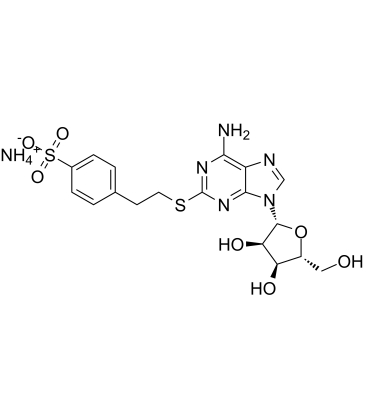| Description |
PSB 0777 ammonium is a potent and selective adenosine A2A receptor full agonist with Ki values of 44.4 nM, 360 nM for rat and human A2A receptors, respectively. PSB 0777 ammonium has Ki values of ≥10000 nM, 541 nM for rat and human A1 receptors, respectively. PSB 0777 ammonium shows poor brain penetrant and perorally non-absorbable effect. PSB 0777 ammonium has the potential for inflammatory bowel disease (IBS) research research[1][2][3].
|
| Related Catalog |
|
| Target |
Ki: 44.4 nM (rat A2A), 360 nM (human A2A), ≥10000 nM (rat A1) and 541 nM (human A1)[1]
|
| In Vitro |
PSB 0777 ammonium (compound 7) shows high selectivity for the A2AAR (>225-fold) versus the other AR subtypes (Ki values of >10000 nM and ≫10000 for human A2B receptor and A3 receptor, respectively). PSB 0777 ammonium acts as an full agonist at A2AAR with an EC50 value of 117 nM in CHO-K1 cells[1]. PSB-0777 ammonium binds human β1 (Ki=4.4 μM) and β3 (Ki=3.3 μM) adrenergic receptors[2]. PSB 0777 ammonium (0.1 µM, 1 µM, 10 µM) increases concentration-dependently Acetylcholine (Ach, 1 mM) contractions in untreated and inflamed rat ileum/jejunum preparations in ex vivo experiments[1].
|
| In Vivo |
PSB 0777 ammonium (0.4 mg/kg/day; oral gavage; from the day 5 to 10) causes a marked reduction of inflammatory cell infiltration and an amelioration of colonic mucosal architecture[3]. PSB 0777 ammonium (0.03, 0.3, 3 mg/kg; i.p.) causes dose-dependent hypothermia and hypoactivity in C57BL/6J mice[2]. PSB 0777 ammonium cannot be absorbed systemically by the digestive mucosa once administered by the oral route. PSB 0777 ammonium (0.4 mg/kg/day; PO) has very low plasma concentrations in rats at 30 min (below 5 nM), and there is no plasma concentrations at 60 min after administration. PSB 0777 ammonium (0.4 mg/kg/day; IP) makes plasma concentrations well evident at 30 min, and decreases after 60 min, and is not detectable at 120 and 240 min[3]. Animal Model: Albino male Sprague-Dawley rats of 200 g with Oxazolone-induced colitis[3] Dosage: 0.4 mg/kg Administration: Oral gavage; daily; from the day 5 to 10 Result: Caused a marked reduction of inflammatory cell infiltration and an amelioration of colonic mucosal architecture alone or in combination with Dexamethasone (1 mg/kg/day). Counteracted significantly the increment of colonic myeloperoxidase (MPO) levels associated with colitis.
|
| References |
[1]. Ali El-Tayeb, et al. Development of Polar Adenosine A2A Receptor Agonists for Inflammatory Bowel Disease: Synergism with A2B Antagonists. ACS Med Chem Lett. 2011 Oct 10;2(12):890-5. [2]. Jesse Lea Carlin, et al.Activation of adenosine A 2A or A 2B receptors causes hypothermia in mice. Neuropharmacology. 2018 Sep 1;139:268-278. [3]. L Antonioli, et al. Anti-inflammatory effect of a novel locally acting A 2A receptor agonist in a rat model of oxazolone-induced colitis. Purinergic Signal. 2018 Mar;14(1):27-36.
|
